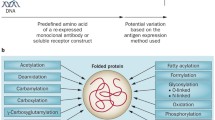Abstract
The European Medicines Agency’s recent approval of biosimilars and their sudden appearance on the market will revolutionize the way physicians treat the severe conditions for which biologics have had a major impact. In the field of rheumatology, these agents are especially important because most new treatments are based on this kind of medication and because patents on the original drugs are expiring. To use these new medications, the treating physician must read and understand the clinical trials related to biosimilars. These studies are not the typical superiority trials in which new agents are compared with standard treatment; rather, they evaluate different formulas to determine whether they are no better or worse. This article summarizes the clinical aspects of drug development with regard to the efficacy and safety of these new medications.
Similar content being viewed by others
References
Pollack A. The New York Times. Published: January 28, 2013. (http://www.nytimes.com/2013/01/29/business/battle-in-states-on-generic-copies-of-biotech-drugs).
Mysler E, Scheinberg. Biosimilars in rheumatology. A view from Latin America. Clin Rheumatol. 2012;31(9):1279–80.
Saag KG, Teng GG, Patkar NM, Anuntiyo J, Finney C, Curtis JR, et al. American College of Rheumatology: American College of Rheumatology 2008 recommendations for the use of nonbiologic and biologic diseasemodifying antirheumatic drugs in rheumatoid arthritis. Arthritis Rheum. 2008;59:762–84.
Schneider CK. Biosimilars in rheumatology: the wind of change. Ann Rheum Dis. 2013;7:315–8.
US Department of Health and Human Services, Food and Drug Administration, Center for Drug Evaluation and Research (CDER), et al. Guidance for industry: scientific considerations in demonstrating biosimilarity to a reference product (draft). 2012. Available from: http://www.fda.gov/downloads/Drugs/GuidanceComplianceRegulatoryInformation/Guidances/UCM291128.pdf (accessed May 2013).
World Health Organization (WHO). Guidelines on evaluation of similar biotherapeutic products (SBPs). 2009. Available from: http://www.who.int/biologicals/areas/biological_therapeutics/BIOTHERAPEUTICS_FOR_WEB_22APRIL2010.pdf (accessed May 2013).
Guideline on the clinical investigation of the pharmacokinetics of 228 therapeutic proteins (CHMP/EWP/89249/2004).
Expert committee on biological standardization, Geneva, 19 to 23 October 2009 Guidelines on evaluation of similar biotherapeuthic products (SBPs, WHO).
Guideline on the choice of the non-inferiority margin. (http://www.ema.europa.eu/docs/en_GB/document_library/Scientific_guideline/2009/09/WC500003636.pdf).
Joung J, Robertson JS, Griffiths E, Knezevic I. WHO informal consultation on regulatory evaluation of therapeutic biological medicinal products held at WHO Headquarters, Genebra, 19–20 April 2007. Biologicals. 2008;36(4):269–76.
Laster LL, Johnson MF, Kotler ML. Non-inferiority trial: the at least as good as’ criterion with dichotomous data. Stat Med. 2006;25:1115–30.
Dorner T, Strand V, Castaneda-Hernandez G, et al. The role of biosimilars in the treatment of rheumatic diseases. Ann Rheum Dis. 2013;72:322–8.
Sandborn WJ, Hanauer SB, Katz S, Safdi M, Wolf DG, Baerg RD, et al. Etanercept for active Crohn’s disease: a randomized, double-blind, placebo-controlled trial. Gastroenterology. 2001;121(5):1088–94.
Colombel JF, Sandborn WJ, Rutgeerts P, Enns R, Hanauer SB, Panaccione R, et al. Adalimumab for maintenance of clinical response and remission in patients with Crohn’s disease: the CHARM trial. Gastroenterology. 2007;132(1):52–65.
Keystone E, Genovese MC, Klareskog L, Hsia EC, Hall S, Miranda PC, et al. Golimumab in patients with active rheumatoid arthritis despite methotrexate therapy: 52-week results of the GO-FORWARD study. Ann Rheum Dis. 2010;69(6):1129–35.
Smolen JS, Kay J, Doyle MK, Landewé R, Matteson EL, Wollenhaupt J, et al. Golimumab in patients with active rheumatoid arthritis after treatment with tumour necrosis factor alpha inhibitors (GO-AFTER study): a multicentre, randomised, double-blind, placebo-controlled, phase III trial. Lancet. 2009;374(9685):210–21.
Emery P, Fleischmann RM, Moreland LW, Hsia EC, Strusberg I, Durez P, et al. Golimumab, a human anti-tumor necrosis factor alpha monoclonal antibody, injected subcutaneously every four weeks in methotrexate-naive patients with active rheumatoid arthritis: twenty-four-week results of a phase III, multicenter, randomized, double-blind, placebo-controlled study of golimumab before methotrexate as first-line therapy for early-onset rheumatoid arthritis. Arthritis Rheum. 2009;60(8):2272–83.
Guideline on similar biological medicinal products containing biotechnology-derived proteins as active substance: non-clinical and clinical issues. EMA 03 June May 2013 EMEA/CHMP/BMWP/42832/2005 Rev. Committee for Medicinal Products for Human Use (CHMP).
Dranitsaris G, Amir E, Dorward K. Biosimilars of biological drug therapies: regulatory, clinical and commercial considerations. Drugs. 2011;71:1527–36.
Guideline on immunogenicity assessment of biotechnology-derived therapeutic proteins EMEA/CHMP/BMWP/14327/2006.
Guideline on immunogenicity assessment of monoclonal antibodies intended for in-vivo clinical use. EMA/CHMP/BMWP/86289/2010.
Krieckaert CL, Jamnitski A, Nurmohamed MT, Kostense PJ, Boers M, Wolbink G. Comparison of long-term clinical outcome with etanercept treatment and adalimumab treatment of rheumatoid arthritis with respect to immunogenicity. Arthritis Rheum. 2012;64(12):3850–5.
WHO Drug Information Vol 23, No. 2, 2009
Schellekens H. Immunogenicity of therapeutic proteins: clinical implications and future prospects. Clin Ther. 2002;24:1720–40.
Lamarque V, Merle L. Generics and substitution modalities: proposed methods for the evaluation of equivalence, traceability and pharmacovigilance reporting. Therapie. 2008;63:311–9.
Compliance with Ethics Guidelines
Conflict of Interest
Eduardo Mysler declares no conflict of interest.
Human and Animal Rights and Informed Consent
This article does not contain any studies with human or animal subjects performed by any of the authors.
Author information
Authors and Affiliations
Corresponding author
Additional information
This article is part of the Topical Collection on Biosimilars
Rights and permissions
About this article
Cite this article
Mysler, E. Biosimilars: Clinical Interpretation and Implications for Drug Development. Curr Rheumatol Rep 17, 8 (2015). https://doi.org/10.1007/s11926-014-0483-y
Published:
DOI: https://doi.org/10.1007/s11926-014-0483-y




